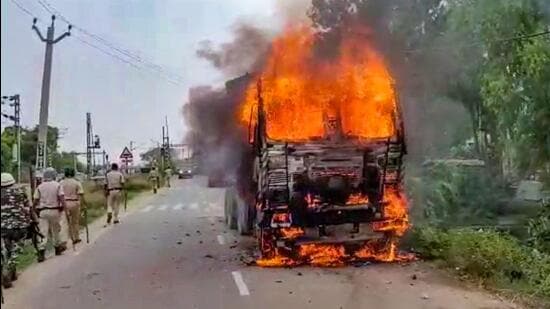Anxiety over quality and quantity of jobs may be behind Agnipath protests
The reforms were announced at a time with the economy is coping with the pandemic’s disruption which has heightened economic anxieties, especially for those at the bottom of the pyramid. Here are four charts which explain this in detail
Protests over Agnipath or the new recruitment scheme for armed forces continued for the third day in various parts of the country on June 17. The Agnipath protests are the second major backlash the current government has faced over a policy decision -- the first being that against the three farm laws which were passed in 2020 and repealed in 2021.

The government’s position is that protestors are not fully aware of the benefits of the new scheme. This is the same logic which was given during the farmers’ protests as well and Prime Minister Narendra Modi while announcing the repeal of the farm laws accepted that it was the government’s fault that it could not convince people about the benefits of the farm laws.
Many commentators have attributed the protests to the growing unemployment problem. There were large-scale protests and violence over railway recruitments earlier this year as well.
But there is another reason why key reform moves such as farm laws and Agnipath have faced such a backlash. This may have to do with the fact that these reforms were announced at a time with the economy is coping with the pandemic’s disruption which has led to a worsening of material conditions for a large number of people and heightened economic anxieties, especially for those at the bottom of the pyramid. Here are four charts which explain this in detail.
Farm laws created a perception of big-business takeover of farming at a time when agriculture had emerged as employer of the last resort
If one were to list two most important economic statistics which capture the impact of the pandemic on the Indian economy, it would be the largest ever GDP contraction in 2020-21 and an increase in the employment share of agriculture. As millions of migrant workers headed back home during the 68-day long lockdown, they found employment of last resort on their family farms.
Experts saw the disillusionment and inadequacy of urban earnings as a major reason why the younger population was attracted back to farms. “The seeming paradox of urbanised Jat youth participating in farmers’ protests is thus resolved when we understand the dual urban-rural lives and livelihood strategies necessitated by India’s simultaneous agrarian crisis and jobless growth… By pushing corporate capital and big agribusiness, the farm laws passed in 2020 by the BJP government created fear among the farmers of losing land that remains essential to even diversified livelihoods”, Satendra Kumar wrote in Journal of Peasant Studies Article published in November 2021. Kumar’s argument raises an interesting counterfactual. Had the government waited for the economy to improve, would the farm law protests have enjoyed a similar traction, especially among young people?
Fear of armed forces jobs disappearing have come at a time when job quality has fallen sharply after the pandemic
The 2020-21 report of the Periodic Labour Force Survey (PLFS) shows this clearly. Even though unemployment rates have fallen, there are signs of a qualitative worsening in the labour market. Share of salaried jobs, jobs with social security benefits and government jobs have come down compared to earlier period, while share of people employed in unpaid labour has increased. On most of these fronts, younger workers are worse off than their older peers. Even the perception (even if it is an erroneous one) of a big sources of jobs with social security going away at such a time is bound to add to the already existing anxiety in the job market.
The relatively poor are excluded from accessing education which will unlock income opportunities in the new economy
One can always argue that India’s young workers should look beyond old-style government jobs and set their sights on India’s dynamic new-economy which consists of sectors such as IT and the rapidly growing start-up eco-system. This is easier said than done because the ability to land these kind of jobs is directly linked to access to technical education rather than the generic college/university based education which does not really enhance employability of the students. Because technical education is far more expensive than general education, the poor find it difficult to enrol in these programmes. This can be seen clearly in data from a 2017-18 National Statistical Office (NSO) survey on education which shows that students from poorer households are disproportionately represented in general education programmes whereas the rich have a much larger representation in professional and technical education programmes.
To be sure, the government believes that the New Education Policy (NEP) will overhaul the existing higher education scene in the country and bring much needed focus on employability in education. The question is, should the government have waited for the perceived fruits of NEP to be realised before asking the youth to shift their aspirations from government jobs to the better paying ones in the new economy?
Get Current Updates on India News, Lok Sabha Election 2024 live, Infosys Q4 Results Live, Elections 2024, Election 2024 Date along with Latest News and Top Headlines from India and around the world.
Continue reading with HT Premium Subscription




